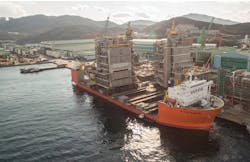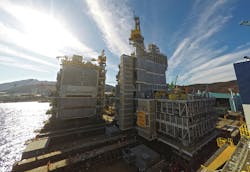Martin Linge modules weighed and loaded in three-month operation
Skidding approach improves control of forward motion
Edwin Blösser
Teun Van Gorp
ALE
Weighing and load-out operations for the Martin Linge process module in South Korea. (Photos courtesy ALE)
ALE has successfully weighed and loaded-out two large topsides structures (the utility and process modules) for the Martin Linge platform in the Norwegian North Sea. Both were built at the Samsung Heavy Industries yard in Geoje Island, South Korea.
The company’s 21-strong on-site crew comprised a dedicated project manager, two specialist engineers, two supervisors and 12 operators, who worked a day and night shift, and four others monitoring the quay jacks under day and night shifts. In addition, Samsung assigned 48 workers, also divided between day and night shifts, for cleaning the Teflon pads during the skidding operation and for removal of equipment from the heavy transport vessel (HTV).
During construction of the modules the team performed two intermediate weighings. For the subsequent load-out and offshore installation, the Center of Gravity (CoG) and weight were critical, and this necessitated verification that the anticipated weights and CoG were in line with the actual values. The first intermediate weighing took place in July 2016 when around 80% of all the steelwork had been installed. A second intermediate weighing followed in January 2017 and nine months later in October, ALE equipment and personnel were again mobilized to undertake the final weighings and the load-out.
Initially the company’s specialist Offshore Services division performed weighing operations for the utility module, using 24,600-metric ton (27,117-ton) capacity weightors. For the process module the crew deployed 32,600-metric ton (35,935-ton) capacity weightors supported by a centrally-controlled synchronized weighing system. This allowed the client to receive the results of the module weights and CoG positions in real time. The utility module weighed 9,580 metric tons (10,560 tons) and the process module 10,850 metric tons (11,960 tons).
After the weighing equipment had been removed, all the skidding equipment was installed. The modules were then loaded-out onto the same vessel in two separate operations. First to be loaded-out was the utility module, with the crew installing 30,650-metric ton (33,786-ton) skid shoes divided over five beneath the building supports to take the load of the module. The same type of skid tracks was placed on the HTV, with five link beams used to bridge the gap between the quay and the vessel. Using 10 83-metric ton (91.5-ton) push pulls, the module was pushed forward with a friction of around 5%. Load-out took place at the end of November and lasted around 10 hours from the start position to the set-down position.
For the load-out of the process module in December, the team employed 24,650-metric ton (27,172-ton) skid shoes and four 800-metric ton (882-ton) skid shoes, divided over seven skid tracks. The process module was driven forward using 12 83-metric ton (91-ton) push-pull units, which meant that the module could be quickly skidded back if load-out needed to be aborted. In addition, the module was fully secured from free sliding due to its locking system. Load-out of this structure was completed within around 10 hours from the start position to the set-down position.
As both the modules had a high CoG, it was a challenge to load them out onto the same vessel and simultaneously maintain the vessel’s stability. ALE addressed this task via a computerized skidding system, with quay jacks to monitor the load. As this methodology was completely new for both the yard and end-client, the team performed extensive calculations and method statements prior to both operations. The methodology was employed for the first time during the first load-out, almost as a ‘practice run.’ However, all ran smoothly and the same applied during deployment of this approach for the second, load-out (which was heavier and more complex), the program being completed without any hitches.
Using the computerized skidding system, the crew could retain better control over the movement of the module that was being loaded-out. This was particularly evident during the crossing of the link beam, as the team could control the speed of the forward motion to enable the heavy transport vessel owner to better monitor and control the ballasting operation. Another advantage of this system was that it provided superior control when the module was close to its end position, with the crew able to inch forward the module to its exact set-down position. This proved to be a great advantage, as it meant the time needed to position the modules was reduced.
Due to the low stability of the HTV during the load-out, quay jacks were used, with four outriggers attached to the vessel’s side. To safeguard against any movement of the vessel, the crew installed 600-metric ton (661-ton) jacks under these outriggers with a steel plate with Teflon on top. The jacks were maintained at the same height and by reading out the loads on the jacks the vessel’s ballast team achieved the correct ballasting for the load-out. During the load-out operation, the load was maintained at between 500 and 1,500 metric tons (551 and 1,653 tons) on the quay.
ALE conducted daily toolbox talks as standard to inform all parties what tasks were planned for that day, and any associated safety considerations. The client also made changes to the time schedule. Initially it requested completion of the load-out within just three days, but due to congestion on the site and time pressures, decided instead to separate the two load-out operations by around one month to ensure that everything was properly prepared and ready.
In the event, operations took around three months to complete, with the final load-out completed in December. Following transportation from the Far East, the modules will be installed in the Norwegian North Sea using a floating crane.


